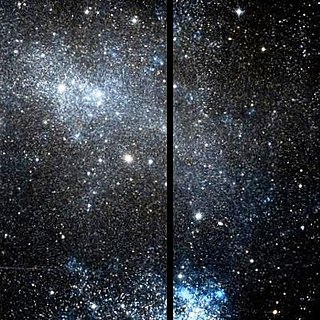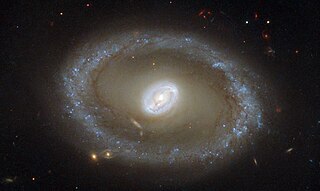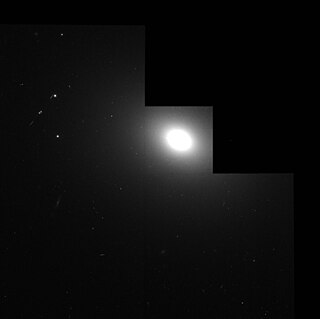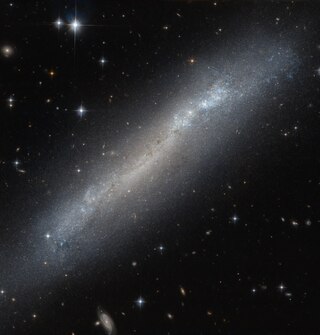
NGC 404 is a field galaxy located about 10 million light years away in the constellation Andromeda. It was discovered by William Herschel in 1784, and is visible through small telescopes. NGC 404 lies just beyond the Local Group and does not appear gravitationally bound to it. It is located within 7 arc-minutes of second magnitude star Mirach, making it a difficult target to observe or photograph and granting it the nickname "Mirach's Ghost".

IC 1613 is an irregular dwarf galaxy, visible in the constellation Cetus near the star 26 Ceti. It was discovered in 1906 by Max Wolf, and is approaching Earth at 234 km/s.

IC 342 is an intermediate spiral galaxy in the constellation Camelopardalis, located relatively close to the Milky Way. Despite its size and actual brightness, its location behind dusty areas near the galactic equator makes it difficult to observe, leading to the nickname "The Hidden Galaxy", though it can readily be detected even with binoculars. If the galaxy were not obscured, it would be visible by naked eye. The dust makes it difficult to determine its precise distance; modern estimates range from about 7 million light-years (Mly) to about 11 Mly. The galaxy was discovered by William Frederick Denning in 1892. It is one of the brightest in the IC 342/Maffei Group, one of the closest galaxy groups to the Local Group. Edwin Hubble first thought it to be in the Local Group, but it was later determined not to be a member.

UGCA 86 is a Magellanic spiral galaxy. It was first thought to be part of the Local Group, but after the brightest stars in the galaxy were observed, it became clear that it was located in the IC 342/Maffei Group. UGCA 86 is thought to be a satellite galaxy of IC 342, however the separation between the two galaxies is over 50% larger than the distance between the Milky Way and the Magellanic Clouds.

NGC 1964 is a barred spiral galaxy in the constellation Lepus. The galaxy lies 65 million light years away from Earth, which means, given its apparent dimensions, that NGC 1964 is approximately 100,000 light years across. At its center lies a supermassive black hole, with estimated mass 2.5 × 107M☉. The galaxy features two tightly wound inner spiral arms within a disk with high surface brightness and two outer, more open spiral arms that originate near the inner ring. The outer arms feature few small HII regions.

NGC 3642 is a spiral galaxy in the constellation Ursa Major. The galaxy has a low-ionization nuclear emission-line region. It is located at a distance of circa 30 million light years from Earth, which, given its apparent dimensions, means that NGC 3642 is about 50,000 light years across. The galaxy is characterised by an outer pseudoring, which was probably formed after the accretion of a gas rich dwarf galaxy.

NGC 4274 is a barred spiral galaxy located in the constellation Coma Berenices. It is located at a distance of circa 45 million light years from Earth, which, given its apparent dimensions, means that NGC 4274 is about 95,000 light years across. It was discovered by William Herschel in 1785.

NGC 4699 is an intermediate spiral galaxy located in the constellation Virgo. It is located at a distance of about 65 million light years from Earth, which, given its apparent dimensions, means that NGC 4699 is about 85,000 light years across. It was discovered by William Herschel in 1786. It is a member of the NGC 4699 Group of galaxies, which is a member of the Virgo II Groups, a series of galaxies and galaxy clusters strung out from the southern edge of the Virgo Supercluster.

NGC 3941 is a barred lenticular galaxy located in the constellation Ursa Major. It is located at a distance of circa 40 million light years from Earth, which, given its apparent dimensions, means that NGC 3941 is about 40,000 light years across. It was discovered by William Herschel in 1787.

NGC 3726 is a barred spiral galaxy located in the constellation Ursa Major. It is located at a distance of circa 45 million light years from Earth, which, given its apparent dimensions, means that NGC 3726 is about 85,000 light years across. It was discovered by William Herschel on February 5, 1788.

NGC 3081 is a barred lenticular ring galaxy in the constellation of Hydra. NGC 3081 is located about 85 million light-years away from Earth, which means, given its apparent dimensions, that NGC 3081 is approximately 60,000 light-years across. It is a type II Seyfert galaxy, characterised by its bright nucleus. It was discovered by William Herschel on 21 December 1786.

NGC 3893 is a spiral galaxy located in the constellation Ursa Major. It is located at a distance of circa 50 million light years from Earth, which, given its apparent dimensions, means that NGC 3893 is about 70,000 light years across. It was discovered by William Herschel on February 9, 1788. NGC 3893 interacts with its satellite, NGC 3896.

NGC 2336 is a barred spiral galaxy located in the constellation Camelopardalis. It is located at a distance of circa 100 million light years from Earth, which, given its apparent dimensions, means that NGC 2336 is about 200,000 light years across. It was discovered by Wilhelm Tempel in 1876.

NGC 3367 is a barred spiral galaxy located in the constellation Leo. It is located at a distance of about 120 million light years from Earth, which, given its apparent dimensions, means that NGC 3367 is about 85,000 light years across. It was discovered by William Herschel on March 19, 1784.

NGC 5965 is a spiral galaxy located in the constellation Draco. It is located at a distance of circa 150 million light years from Earth, which, given its apparent dimensions, means that NGC 5965 is about 260,000 light years across. It was discovered by William Herschel on May 5, 1788.

NGC 6907 is a spiral galaxy located in the constellation Capricornus. It is located at a distance of about 120 million light-years from Earth, which, given its apparent dimensions, means that NGC 6907 is about 115,000 light-years across. It was discovered by William Herschel on July 12, 1784. The total infrared luminosity of the galaxy is 1011.03 L☉, and thus it is categorised as a luminous infrared galaxy.

IC 1459 is an elliptical galaxy located in the constellation Grus. It is located at a distance of circa 85 million light-years from Earth, which, given its apparent dimensions, means that IC 1459 is about 130,000 light-years across. It was discovered by Edward Emerson Barnard in 1892.

IC 5201 is a barred spiral galaxy located in the constellation Grus. It is located at a distance of about 35 million light years from Earth, which, given its apparent dimensions, means that IC 5201 is about 90,000 light years across. It was discovered by Joseph Lunt in 1900.

NGC 5363 is a lenticular galaxy located in the constellation Virgo. It is located at a distance of circa 65 million light years from Earth, which, given its apparent dimensions, means that NGC 5363 is about 100,000 light years across. It was discovered by William Herschel on January 19, 1784. It is a member of the NGC 5364 Group of galaxies, itself one of the Virgo III Groups strung out to the east of the Virgo Supercluster of galaxies.

NGC 2188 is a barred spiral galaxy in the constellation Columba. It is located at a distance of circa 25 million light years from Earth, which means that the galaxy, given its apparent dimensions is about 50.000 light years long. It was discovered by John Herschel on January 9, 1836.




















